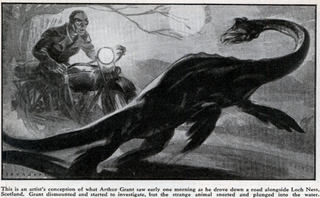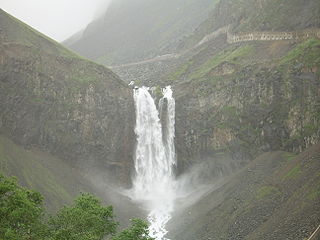| Sub grouping | Lake monster |
|---|---|
| First attested | 1903 |
| Other name(s) | Lake Chonji Monster |
| Country | China/North Korea |
| Region | Heaven Lake |
| Details | Found in water |
Lake Tianchi Monster is the name given to what is said to be a lake monster that lives in Heaven Lake (known as Cheonji in Korean) located in the peak of Baekdu Mountain within the Baekdu-daegan and Changbai mountain ranges encompassing Jilin Province of China and Ryanggang Province of North Korea. [1] According to Beijing Youth Daily, an estimated 20 monsters were reported; [2] however, "scientists are skeptical that any large creature would be able to survive in the lake given its recent history of volcanic activity", [3] and skeptics say "it's all in the imagination, or just a floating volcanic rock". [4]
The first reported sighting was in 1903. It was claimed that a large buffalo-like creature attacked three people, but was shot six times. The monster then retreated under the water. [2]
In 21 to 23 August 1962, a person using a telescope reportedly saw two of the monsters chasing each other in water. More than a hundred people reported the sightings.
More recent reports describe the monster as having a human-like head attached to a 1.5-meter (5 ft) neck. It is said to have a white ring around the bottom of its neck, and the rest of its skin is grey and smooth. [2]
In 2007, Zhuo Yongsheng, a Chinese TV reporter said he had shot a 20-minute video of six unidentified creatures in the volcanic lake on 6 September. [5] [6] He later sent still photos to Xinhua's Jilin provincial bureau. According to a news report one of these showed the six "Nessies" swimming in parallel in three pairs. Another one of them featured the animals closer together, leaving circular ripples on the lake surface.
Zhuo said he had seen the six seal-like, finned creatures swimming and frolicking in the lake for an hour and a half, before they disappeared around 7:00 a.m. "They could swim as fast as yachts and at times they would all disappear in the water. It was impressive to see them all acting at exactly the same pace, as if someone was giving orders," he said. "Their fins—or maybe wings—were longer than their bodies." [7]
The Mountain Goats' 2008 album, Heretic Pride features the song, "Tianchi Lake" about the monster: "Backstroking on the surface, moonlight on its face / Floats the Tianchi monster, staring into space."

The Loch Ness Monster, also known as Nessie, is a mythical creature in Scottish folklore that is said to inhabit Loch Ness in the Scottish Highlands. It is often described as large, long-necked, and with one or more humps protruding from the water. Popular interest and belief in the creature has varied since it was brought to worldwide attention in 1933. Evidence of its existence is anecdotal, with a number of disputed photographs and sonar readings.

Paektu Mountain or Baekdu Mountain (Korean: 백두산) is an active stratovolcano on the Chinese–North Korean border. In China, it is known as Changbai Mountain. At 2,744 m (9,003 ft), it is the tallest mountain in North Korea and Northeast China and the tallest mountain of the Baekdu-daegan and Changbai mountain ranges. The highest peak, called Janggun Peak, belongs to North Korea. The mountain notably has a caldera that contains a large crater lake called Heaven Lake, and is also the source of the Songhua, Tumen, and Yalu rivers. Korean and Manchu people assign a mythical quality to the mountain and its lake, and consider the mountain to be their ancestral homeland.

Sea monsters are beings from folklore believed to dwell in the sea and are often imagined to be of immense size. Marine monsters can take many forms, including sea dragons, sea serpents, or tentacled beasts. They can be slimy and scaly and are often pictured threatening ships or spouting jets of water. The definition of a "monster" is subjective; further, some sea monsters may have been based on scientifically accepted creatures, such as whales and types of giant and colossal squid.

A lake monster is a lake-dwelling entity in folklore. The most famous example is the Loch Ness Monster. Depictions of lake monsters are often similar to those of sea monsters.

In Canadian folklore, the Ogopogo is a lake monster said to inhabit Okanagan Lake in British Columbia, Canada. Some scholars have charted the entity's development from First Nations folklore and widespread water monster folklore motifs. The Ogopogo now plays a role in the commercial symbolism and media representation of the region.

Heaven Lake is a volcanic crater lake atop Baekdusan. It lies on the border between China and North Korea, and is roughly evenly divided between the two countries.

In Swedish folklore, the Storsjöodjuret is a lake monster said to live in the 90-metre-deep (300 ft) lake Storsjön in Jämtland in the middle of Sweden.

Scottish mythology is the collection of myths that have emerged throughout the history of Scotland, sometimes being elaborated upon by successive generations, and at other times being rejected and replaced by other explanatory narratives.

Jon-Erik Beckjord was an American paranormal investigator, photographer, and cryptozoologist interested in UFOs, crop circles, the Loch Ness Monster, and Bigfoot. Throughout his life, he owned three separate, small-scale museums that featured displays, mostly photographs, of alleged UFO, Nessie, and Bigfoot sightings. He made guest appearances on national radio and television shows, but was criticized by skeptics and fellow cryptozoologists alike for not providing substantive evidence to back up his claims of the existence of paranormal beings.

In American folklore, Champ or Champy is the name of a lake monster said to live in Lake Champlain, a 125-mile (201 km)-long body of fresh water shared by New York and Vermont, with a portion extending into Quebec, Canada. The legend of the monster is considered a draw for tourism in the Burlington, Vermont and Plattsburgh, New York areas.
In Pahang Malay folklore, the Seri Gumum Dragon is a legendary giant serpent locally called Nāga and commonly described as taking the form of an Asian dragon, that inhabit the Chini Lake in Pahang, Malaysia. There have been a variety of legends associated with the creature in the oral literature. The notable one is related to the origin myth of the lake itself, while another legend narrates about a love story between female Seri Gumum and a male Nāga called Seri Kemboja that leads to the origin myth of Tioman and Lingga Islands.

The Loch Ness Monster is a creature from folklore that has appeared in popular culture in various genres since at least 1934. It is most often depicted as a relict dinosaur or similar, but other explanations for its existence such as being a shapeshifter or from outer space also appear. It is only occasionally portrayed as threatening, despite its name.

Changbai Waterfall is a 68 m (223 ft)-tall alpine waterfall in Northeast China, located to the north slope of the Changbai Mountain, the tallest summit of the Changbai Mountain Range between China and North Korea.
Tahoe Tessie is a cryptid said to inhabit the depths of Lake Tahoe, a lake that straddles the border between California and Nevada. Reports of Tessie date back to the mid-19th century, and over time, the creature has become a well-known part of local folklore.

A water horse is a mythical creature, such as the Ceffyl Dŵr, Capaill Uisce, the bäckahäst, each-uisge, and kelpie.

In Canadian folklore, Cressie is the nickname given to an eel-like lake monster said to reside in Crescent Lake, Robert's Arm, Newfoundland and Labrador, Canada. The name is a portmanteau of Crescent Lake and Nessie, the nickname given to the Loch Ness Monster. The monster has been described as resembling a large dark brown eel around 15 feet in length with a long, sleek body and as "looking long and shiny, and having a fish-like head." Claims of Cressie being sighted began in the 1950s, and continue to the present day.

Lake Ikeda is a caldera lake located 40 km (25 mi) south of Kagoshima city; Kyūshū island, Japan. It is perhaps best known to tourists as the location of the purported sightings of a monster named Issie, and as the largest lake on Kyūshū island with a surface area of 11 km2 (4.2 sq mi) and a shoreline length of 15 km (9.3 mi).

Loch Ness is a large freshwater loch in the Scottish Highlands extending for approximately 37 kilometres southwest of Inverness. It takes its name from the River Ness, which flows from the northern end. Loch Ness is best known for claimed sightings of the cryptozoological Loch Ness Monster, also known affectionately as "Nessie". It is one of a series of interconnected, murky bodies of water in Scotland; its water visibility is exceptionally low due to the high peat content of the surrounding soil. The southern end connects to Loch Oich by the River Oich and a section of the Caledonian Canal. The northern end connects to Loch Dochfour via the River Ness, which then ultimately leads to the North Sea via the Moray Firth.

The Water Horse: Legend of the Deep is a 2007 fantasy film directed by Jay Russell and written by Robert Nelson Jacobs, based on Dick King-Smith's children's novel The Water Horse. It stars Alex Etel as a young boy who discovers a mysterious egg and cares for what hatches out of it: a "water horse" which later becomes the fabled Loch Ness Monster. The film also stars Emily Watson, Ben Chaplin and David Morrissey.
Zegrze Reservoir Monster is a fictional lake monster, that according to an urban legend, lives in the Zegrze Reservoir near the city of Warsaw, Poland. The story was invented by a journalist Wojciech Mazurkiewicz, as a local equivalent to the legend of Loch Ness Monster, and was for the first time mentioned in media in the 1980s.